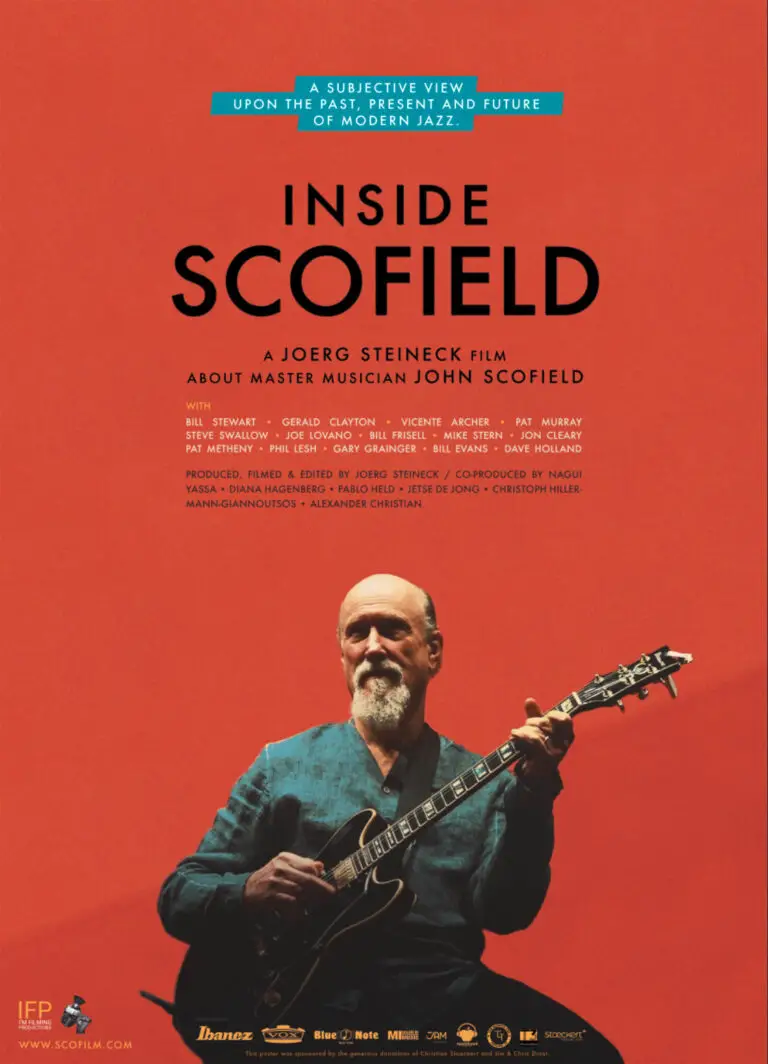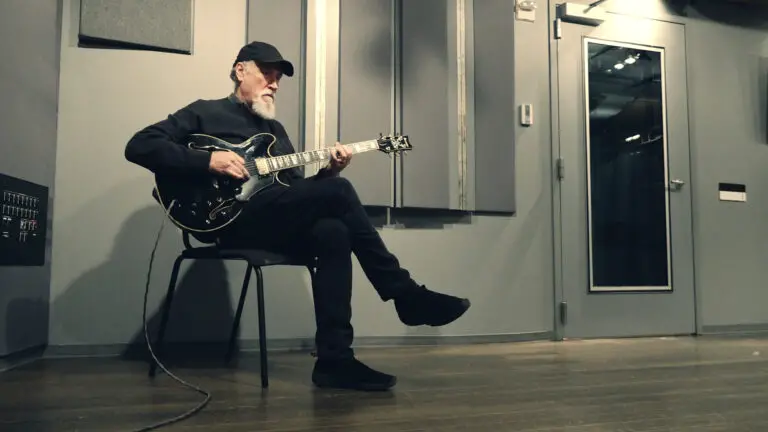With his new documentary, INSIDE SCOFIELD, filmmaker Joerg Steineck has crafted one of the truest representations of the compulsively creative lifestyle of a “road dog” jazz master – in this case, the always superlative guitarist John Scofield.

Steineck makes the incredibly wise decision of letting Scofield tell his story in his own words. This comes via voiceover narration and on-camera interviews captured at his home in Katonah, his old stomping grounds in New York City and on tour in Seattle, Portland, Phoenix and Los Angeles. The documentary also boasts some wonderful conversations with longtime collaborators like saxman Joe Lovano, bassists Steve Swallow and Dave Holland and guitarists Pat Metheny and Mike Stern. There are also insights from other A-list musos including drummer Dennis Chambers, guitarist Bill Frisell and the Grateful Dead’s Phil Lesh.
Scofield’s musical journey begins in his still current hometown of Katonah, New York. For this typical suburban kid, the big treat would be to take the Metro North down to NYC to explore. As he hit his teens, Scofield come to take in jazz at the Village Vanguard, rock at Fillmore East and blues at Café A Go Go, where he witnesses the blues power of B.B. King. In the film, Scofield says: “The way B.B. King played guitar, it just blew my mind. The way he could get this vocal sound out of a guitar. That’s when I really got the bug for music.”
As for his turn to jazz, we may have Jimi Hendrix to thank. Scofield recalls: “I heard Hendrix play at a concert and he was so good at blues and rock that I thought I’m going play jazz because I could never do what he could.”
Jazz becomes his total lifestyle when he attends the Berklee College of Music in Boston. It’s where he meets folks like Lovano and begins collaborating, at the tender age of 20, with bass legend Steve Swallow. Word of this new guitar hotshot spreads to saxman Gerry Mulligan who invites Scofield to play a gig at Carnegie Hall with him and Chet Baker. The next month, he is recommended to replace John Abercrombie in drummer Billy Cobham’s band with George Duke and Alphonso Johnson. Shortly thereafter, he gets to play on an album with jazz icon Charles Mingus.
As Scofield tells of his move to the Big Apple in 1975, there are great scenes of him strolling by his old haunts. These include The Blue Note, the former site of “guitar shop row” on 48th Street, a namecheck for the cheap eats at Mamoun’s Falafels and Seventh Avenue South. It was at the latter where Miles Davis would first hear and then enlist Scofield into his band. After his performance at the club, Miles would say to him: “You sound good.” And when Scofield began effusing about Miles’ immense influence on him, the trumpeter would say: “Shut the fuck up!”
“That was the beginning of our relationship,” quips Scofield. “But just to be around him gave me the confidence that I was on the right path, that I should trust my instincts just like Miles did.”
Much of the action in the film takes place on the road with Scofield and his touring quartet, including keyboardist Gerald Clayton, bassist Vincente Archer and longtime drummer Billy Stewart. We see them traveling in van and airplanes, checking into hotels, sound checking, playing sets and killing time before gigs by visiting local guitar stores. One of the best musical moments in the film has Scofield jamming with bassist Archer on a resonator guitar at a guitar store in the Northwest.
“Since 1975, I’ve been on tour half the year, every year, so I’m what’s called ‘a road dog,’” says Scofield. “In the old days, guys didn’t have to leave New York to make a living, but we do.” In the film, Scofield laments the loss of America’s circuit of jazz clubs, where a musician could play for a week or longer versus flying and driving between one-nighters.

Scofield also provides some enlightening observations on the art of improvisation and the creative alchemy of bands.
“The jazz world is like humanity,” he says. “When your styles match and you can play together, it’s a beautiful thing. You might be different people, but you get along because the music is happening… It’s my band, but once the band starts to play I’m just another member.”
Scofield continues: “Improvisation is a natural human thing. The compositions are meant to be taken apart. They go hand in hand – composition and improvisation… Some people have huge vocabularies and it sounds good but there’s nothing happening. I would like to hope that I’m playing less notes but saying more with them.”
One thing I truly loved about Steineck’s film is that he leaves plenty of time to luxuriate in the fantastic live performances. Steineck’s clips of Scofield and his quartet playing live demonstrate that John remains one of the most original and hardest swinging guitarists in modern jazz. There are also great clips of him playing in duets and solo, demonstrating his deep knowledge of harmony and feel, with those bold arpeggiated lyrical solos and his unflagging blues sensibility. The one thing I did miss was mention of Scofield’s participation in the more mainstream “jam band scene” of the early aughts with his Uberjam band.
Steineck’s documentary concludes with Scofield at home in Katonah. Here he enjoys his “nice espresso machine” and does what he loves most of all – playing . “I need to play every day or I don’t play well,” says Scofield. “It’s my favorite part of the day.”
As Scofield wonders what it would be like if he couldn’t play, the documentary takes a turn, colored by some delightfully weird gong-flavored music. The film concludes with Scofield self-isolating during the early days of the COVID-19 epidemic. We see him commiserating with his longtime playing partner Steve Swallow via Zoom saying, “I feel like I’m in a dystopian situation.”
Luckily for us, Scofield returned to the road as COVID abated. And some of the works of the ensembles featured in the film, his 2018 quartet and duo work with Steve Swallow, can be enjoyed on Combo 66 (Verve, 2018) and Swallow Tales (ECM, 2020). Also, not to be missed is the 2017 album Hudson, a collection of covers he made with Hudson Valley-based musicians, Jack DeJohnette, Larry Grenadier and John Medeski.
INSIDE SCOFIELD is available on DVD and video on demand on Vimeo. It will be coming to other platforms in 2023.


Comments are closed.